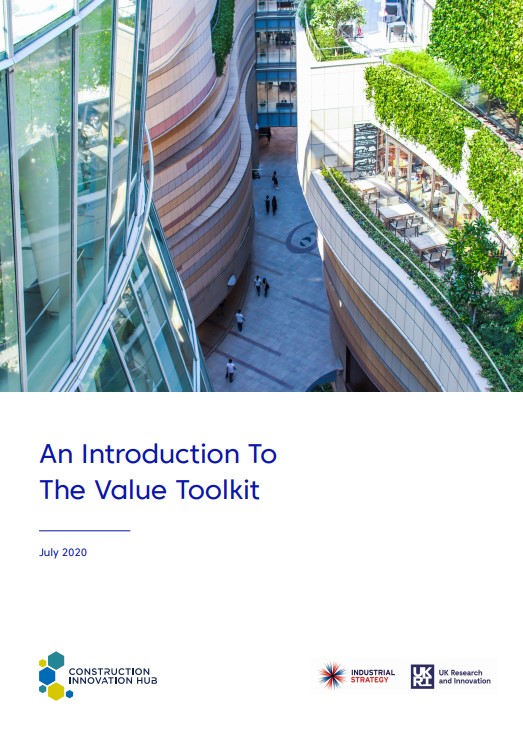The Value Toolkit
Contents |
[edit] Introduction
On 16 July 2020, the Construction Innovation Hub introduced the Value Toolkit. The launch of the initiative, which is supported by the Government, came during UK Research and Innovation’s Future of Building Week. The Toolkit is backed by the Industrial Strategy Challenge Fund, part of the Government’s long-term plan to raise construction productivity.
The Construction Innovation Hub’s website offers an overview of the Toolkit’s primary purpose, which is “...to support better decision making throughout the whole investment life cycle from business case through to procurement and delivery and operation, improving overall sector performance consistent with key policy objectives such as driving Modern Methods of Construction (MMC), delivering social impact and accelerating the path towards net zero.”

|
[edit] Examining the Toolkit
A discussion about the Value Toolkit with some key thought leaders began with insights about the definition of the term ‘value’, particularly as it relates to safe, high quality buildings.
Keith Waller, Programme Director at the Construction Innovation Hub, opened the conversation by acknowledging the significance of the timing of the Toolkit’s release. Waller sees the project as a method of measurement designed to drive value which could work well in conjunction with the Government’s proposed capital investment projects (including residential construction, hospital maintenance and construction, mental health housing, road and bridge repairs, rail infrastructure, school construction and local government facility upgrades), ‘Project Speed’ (a fast track approach intended to create better transportation infrastructure that will include zero carbon buses and cycleways) and the Roadmap to Recovery’ from the Construction Leadership Council (CLC).
Waller went on to discuss one of the concepts at the core of the Toolkit - general perceptions of value. Rather than focusing on the idea of cost (or as he said, “not just cheapness”), he explained that four additional drivers - natural, social, human, manufactured - should be part of the equation. He raised the idea that value should not only be a factor during construction, but it should also be part of the entire life cycle of the building.
Waller closed by raising the issue of buildings as ‘value creating’ rather than ‘value destroying’, particularly in terms of social, economic and environmental outcomes. He expressed his hope that the post COVID-19 vision for construction would be one marked by accelerated decision making, particularly in terms of breaking the status quo.
[edit] Whole life value
Neil Robertson, Chief Executive at the National Skills Academy for Rail, discussed life cycle management and expressed his support for the Toolkit, particularly as it relates to critical transport infrastructure. He noted that the industry has historically been short of its efficiency targets, and he sees the Toolkit as a path to improvement in that area.
An additional examination of value priorities was raised by Ann Bentley, Global Board Director at Rider Levett Bucknall and lead on Supply Chain and Business Models at the Construction Leadership Council. She mentioned the importance of making distinctions between cost and value, stressing that they are not the same thing since value implies the potential for contribution. She introduced the idea that value should be included in the procurement process, but instead of referring to it as value, it might be labelled 'outcome' - again reinforcing the importance of looking at the entire life cycle of a building.
[edit] Applying personal purchasing practices to the business world
Hannah Vickers, Chief Executive at the Association for Consultancy and Engineering, introduced the idea of applying personal procurement behaviours to those used in business. She recognised that some purchases made are simply based on lowest cost, but she also suggested that many people put more thought into large purchases and think about the overall investment in the item. Vickers suggested that the Toolkit might be able to help clients get a better understanding of their purchasing decisions so they can develop projects that deliver more desirable outcomes.
Huda As'ad, Head of Performance for the Commercial Advisor Team at the Infrastructure and Projects Authority spoke about infrastructure performance and the aspiration, through Project Speed, to use the Toolkit to build faster, greener and better.
[edit] Additional thoughts and concerns
All of the speakers weighed in during the question and answer session with their opinions about how Brexit could have an impact on the success of the Toolkit along with other proposed infrastructure initiatives. With the possibility of post-Brexit procurement legislation for everything (not just construction), Bentley saw this as an opportunity for 'procurement for the better' with more time spent on planning at the beginning of the process. However, she also countered that with her concerns about urgency, expressing her worry that speed could also result in missed opportunities.
When asked about whether or not the Toolkit was only suitable for new construction or infrastructure projects, Waller stated that different people would be able to use it in different ways, making it suitable at any stage.
As a form of standardisation, the Toolkit could initiate more collaboration, Bentley said, and As'ad noted that the end result would ideally deliver projects that were more resilient and more inspirational.
The Value Toolkit interactive website was launched in December 2020.
See also: BRE welcomes the introduction of the Value Toolkit and ECA welcomes the Value Toolkit for the construction industry
[edit] Related articles on Designing Buildings
- BRE welcomes the introduction of the Value Toolkit.
- Construction Innovation Hub.
- ECA welcomes the Value Toolkit for the construction industry.
- Life cycle in the built environment.
- Modern methods of construction.
- New deal for infrastructure 2020.
- Procurement route.
- Transforming Construction Alliance.
- Why we need to grasp the whole life cycle.
Featured articles and news
UCEM becomes the University of the Built Environment
Major milestone in its 106-year history, follows recent merger with London School of Architecture (LSE).
Professional practical experience for Architects in training
The long process to transform the nature of education and professional practical experience in the Architecture profession following recent reports.
A people-first approach to retrofit
Moving away from the destructive paradigm of fabric-first.
International Electrician Day, 10 June 2025
Celebrating the role of electrical engineers from André-Marie Amperè, today and for the future.
New guide for clients launched at Houses of Parliament
'There has never been a more important time for clients to step up and ...ask the right questions'
The impact of recycled slate tiles
Innovation across the decades.
EPC changes for existing buildings
Changes and their context as the new RdSAP methodology comes into use from 15 June.
Skills England publishes Sector skills needs assessments
Priority areas relating to the built environment highlighted and described in brief.
BSRIA HVAC Market Watch - May 2025 Edition
Heat Pump Market Outlook: Policy, Performance & Refrigerant Trends for 2025–2028.
Committing to EDI in construction with CIOB
Built Environment professional bodies deepen commitment to EDI with two new signatories: CIAT and CICES.
Government Grenfell progress report at a glance
Line by line recomendation overview, with links to more details.
An engaging and lively review of his professional life.
Sustainable heating for listed buildings
A problem that needs to be approached intelligently.
50th Golden anniversary ECA Edmundson apprentice award
Deadline for entries has been extended to Friday 27 June, so don't miss out!
CIAT at the London Festival of Architecture
Designing for Everyone: Breaking Barriers in Inclusive Architecture.
Mixed reactions to apprenticeship and skills reform 2025
A 'welcome shift' for some and a 'backwards step' for others.























